Most vintage ambulances and hearses that pop up here on Barn Finds are usually customized Cadillacs and other high-end vehicles. This 1956 example is the first time I’ve seen one as a Ford Fairlane (or more appropriately a Country Sedan as Ford had different names for wagons in those days). Other than the lights on the roof, it looks like an ordinary 4-door station wagon. It has a Y-block V8 (that replaced the flathead) that might run with a little work. Stored indoors, this dusty Ford is in Paso Robles, California, and is available here on Facebook Marketplace (or it was four weeks ago) for $6,500.
After a major refresh in 1955, the Ford lineup was mostly unchanged in 1956 (it takes a sharp eye to tell them apart aside from turn signals). The portfolio had three basic trim levels, Mainline, Customline, and Fairlane. And within the Fairlane, the station wagons were Country Sedans and Country Squires, with the latter being “woodies” with imitation wood paneling on the sides (the real woodies ended in 1951). So as best we can tell, the seller’s wagon is a 4-door Country Sedan that’s been converted in some fashion to carry the sick and/or wounded.
This dusty and dirty project is said to have a Y-block V8, but they came in three displacements in 1956: 272, 292, and 312 cubic inches (so take your pick as to which one is in the seller’s wagon, original or not). It’s paired with an automatic transmission (Cruise-O-Matic?), There were a lot of these running around when new as Ford built more than 87,000 Country Sedans that year with a variety of door and seating configurations.
We’re told the exterior and interior are brown in color, but white for the outside sounds more logical. And some cosmetic work is needed in the rear (no taillights, for example). If this really was an ambulance and not just a station wagon with extra lights, this could be a cool conversation piece at Cars & Coffee. Hail to “Zappenduster” for another cool tip!
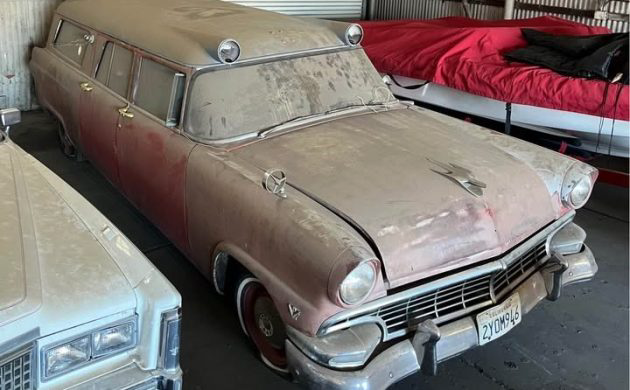
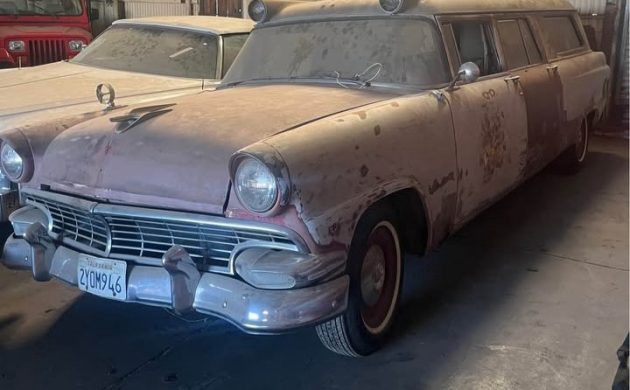
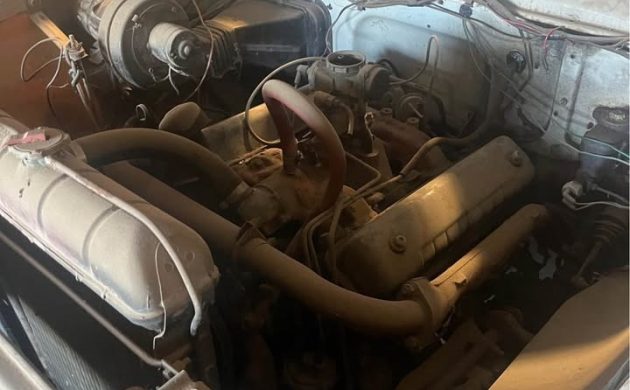
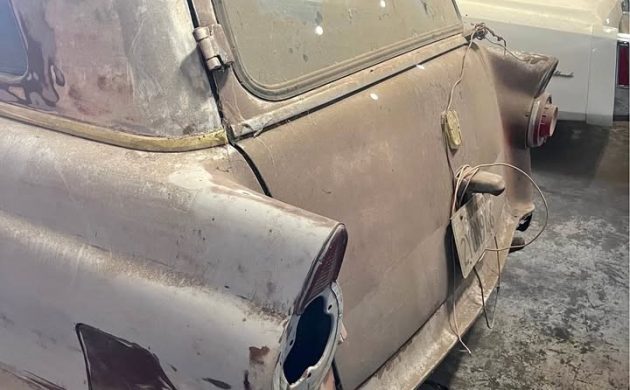
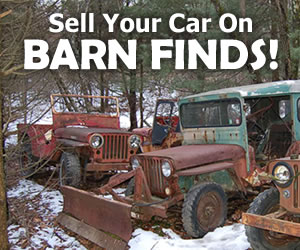
I don’t recall ever seeing a 55-56 Ford wagon ambulance conversion, but I have seen a number of similar 55-57 Chevy wagon conversions. I’ve seen a 59 Ford wagon converted to an ambulance too.
A friend of mine has a black 55 Chevy wagon with a red light on each corner of the roof and white stripes and red crosses on each rear side window. If I remember correctly it came out of a small midwest town where it was owned by the local funeral director and served as both the town’s ambulance and hearse (which is why it was black). I also know someone who use to have a 57 Chevy wagon ambulance. I think the wagon conversion ambulances were probably more popular or common in small towns and rural areas. Generally places that couldn’t either afford, or justify the expense of a Cadillac conversion would buy something like this Ford wagon instead.
A funeral home in Clarksville, TN still has a ’57 Chevy ambulance/hearse (red) in flawless condition and uses it when requested by the family
Don’t need a sharp eye to distiguish a1956 from a 55 if you were a car nut kid in the 50s. The main exterior difference was the grill/turn signals and side. trim, interior was the major dashboard redesign and “optional seat belts—lifeguard design). Pretty much the same with Chevrolet. Sympathy for all of us “born yesterday” when seeing recent car designs.
Thanks for pointing out the differences between ‘55 and ‘56 Ford cars. ‘56 was also the first year for 12 volt. Positive ground. Negative ground in ‘57.
id have to look and have not at time of writing but think tail fins and lights a bit different on 56????
tail fins same tail light lens and frame around backup lights different
There were a number of coach builders who built on a number of chassis. While the majority of the ambulances, hearses, and even coach built limousines were built on the Cadillac and Packard specially built professional chassis, several coach builders built on other makes than Cadillac and Packard. The Henney company out of Freeport Illinois had an exclusive agreement with Packard, and they ONLY built on the Packard professional chassis but in the mid 50s there was also the Superior Coach company out of Lima Ohio, Miller-Meteor company out of Piqua Ohio (prior to 1956 they were two separate companies until the A.J. Miller company merged with the Meteor company to form the Miller-Meteor company), the Eureka Coach company out of Rock Falls IL, the S&S (Sayers and Scoville) division of the Hess & Eisenhardt company which is still in business to this day. The Flxible company built exclusively on the Buick chassis, and there were a number of much smaller companies such as the National company, Comet Coach company and many others. In most companies the OEM company would supply the chassis, but the coach builders would literally drop a specialized body onto the chassis which was designed, engineered, and built entirely by the coach builder. Most of these manufacturers would still utilize specific sheet metal and parts supplied by the OEM (such as the rear quarter panels and fenders), but all the doors, commercial glass etc. were built by the coach builder. Those coach builders who built on a specialized Professional car chassis (like the Packard and Cadillac professional chassis) were usually easily discerned because the windshield was much taller and larger than a non-professional car. Only a well trained eye could tell the individual coach builder based on the vast differences of the specially built bodies that were dropped onto the chassis. But many of the smaller coach builders who built on other chassis than the Cadillac or Packard professional chassis would often times look similar to a regular non professional car because their OEMs didn’t provide a specifically built professional chassis. But because these smaller company built professional cars would utlilize a regular car chassis that would often times be stretched with a specialized body dropped onto the chassis/frame, the front of the car looked identical to regular retail cars but from the windshield back the body was completely designed, engineered, and built by the coach builder. But again, the coach builder would often times still use various components off the OEM supplied body such as again the rear quarter panels making them look similar to regular non professional cars’ station wagons even though most of the body was purpose built. In many cases the only way to tell the difference is by looking into the INTERIOR of the car. Coaches that were built as ambulances would have a flat floor in back, with portions featuring custom built cabinetry, cot hooks to accommodate ambulance stretchers, storage areas for oxygen tanks and equipment, and many even included specialized cabinets in the rear door of the ambulance. Hearses would always feature rollers and other equipment for transporting caskets to and from the funeral to the cemetery, and there were a number of styles of hearses available. The three-way hearses were the most expensive, as they were able to accomodate both side servicing as well as rear servicing of the casket. The most common (and least expensive) hearses were rear only loaders. There were also two main styles of hearses, the “limousine” style hearses featured windows along the sides of the hearse where the “landeau” style hearses had sail panels in lieu of the windows, and usually featured coach builder designed landau bars which easily showed the vehicle as a hearse or funeral coach where the limousine style hearses looked more like a regular station wagon, other than they were usually much longer than an actual non-coach station wagon. The “combination” coaches could serve dual duty as both an ambulance or a hearse. These combination coaches were the most common especially in smaller towns where the funeral homes would also provide ambulance service until the 60s and 70s when funeral homes widely abandoned their ambulance services in favor of the ambulance service being taken over by fire departments, police departments, hospitals, and private ambulance services. I don’t know who the coach builder of this Ford Fairlane based ambulance was, but based on the tunnel lights on the top I can tell this was a coach built vehicle featuring the OEM provided chassis, but the body would have been completely coach built. It’s too bad no interior photos are provided, but such photos would have shown the interior aspects of this coach built ambulance. You can tell that this would have not been built as a hearse or a combination coach, since it has the ambulance configuration body. Many of the ambulances built during these years featured “high headroom” designs where this ambulance appears to be a original roof height design. The high headroom ambulances were often times referred to as “high tops”, where the original headroom examples were often times referred to as “low tops”. The internationally recognized Professional Car Society is devoted to the preservation, history, and restoration of the professionally built ambulances, funeral coaches, and limousines. Their website, the Friends of the Professional Car Society’s website at https://professionalcarsociety.org/ is a treasure trove of information regarding professional cars such as this one. I will post a question on their forum as to the coach builder of this particular example to see if anyone there recognizes which coach builder designed/built this old professional car.
This doesn’t look like a standard issue Country Sedan. There isn’t a good side view, but it seems to have a small stretch. An interesting car for sure. I would hope it gets saved by a member of the Professional Car Society, but other than that I don’t know what you would do with it.
Not a Fairlane as Ford wagons were marketed as a separate series from ’55-’68. Automatic would be a Fordomatic as Cruise-o-Matic wasn’t offered until ’58.
tiger you are right on the automatic but on models the county sedan has 2 models a nine passenger that had Fairlane side tram and a six passenger that had custom line trim 1956 my parents bought a new 9 passenger country sedan red and white with a 312 I was 11 years old remember the car well
When I was a younger kid, the fire department had a Ford ambulance like this. A few years after that I had a 56 Fairlane that I bought from the neighbor/insurance agent. T bird 312, 4 barrel, lap belts and “don’t tell my wife I sold her car for…”.
I doubt that this is a 312 with that carb.
Owner contacted me and said the vehicle SOLD. I asked if he had any original emergency equipment and who used the vehicle when in service. Owner stated no emergency equip and unknown original ownership. This vehicle was probably built by either National or Siebert and stretched out the vehicle for this purpose in the day.
I think this is an Amblewagon . The company converted standard wagons into budget ambulances in the ‘50s and early ‘60s
Hard to see with these pictures, but body looks like a combination of a 4 door wagon and a courier (sedan delivery) Body has a courier hinge on the side of the rear glass and looks like shortened courier rear panels instead of quarter windows. Siebert out of Toledo Ohio and Weller out of Memphis specialized in converting Fords into professional vehicles, especially in the 1950s. Other body conversion companies also did, but in smaller numbers. This one most likely has been an ambulance conversation since new.
I’ve been a fan of professional vehicles as long as I can remember. I have a 50 Chevrolet National Body hearse and have studied the conversation companies specializing in limos, ambulances, hearses and flower cars. Not very practical as collector cars but they are fun to study!
I pulled this 50 Chevy out of a field behind a defunct dirt track about 25 years ago. It had been used as their ambulance. Inside was a really cool vintage stretcher. Still not sure what to do with it, but I couldn’t just let it sink into the dirt.
i want to see more pics!
A couple more pics
I found this car, made a deal over the phone but it was a year later that I had time to get it. The elderly owner had passed away in the mean time so I did some searching and found his son. The son was kind of down on his luck and was more than happy to accept the offer I had made to his Dad. As part of the deal, I got a Coke cooler, about the size of a casket. I loaded the cooler in the hearse and drove it to my barn with the Coke logos perfectly showing through the side and rear door windows.
It was made by the National Body company out of Knightstown Indiana. They stretched a sedan delivery Body using a stock sedan delivery rear door. The added side doors are wood framed with the wood being pretty rotten. I’m afraid if I open them I’ll never get them closed. It’s pretty complete and solid, but the windows had been smashed out so the interior is completely shot.
One more, a picture of a picture just after putting it out of the weeds.
as kid in 60s in rural NY I had an uncle who was funeral director and furniture store owner. He had a 60 Pontiac wagon that used as ambulance as it was common for them to also run ambulance services. This custom conversion was marketed as an Amble-wagon